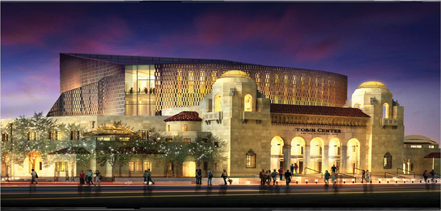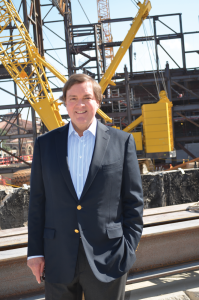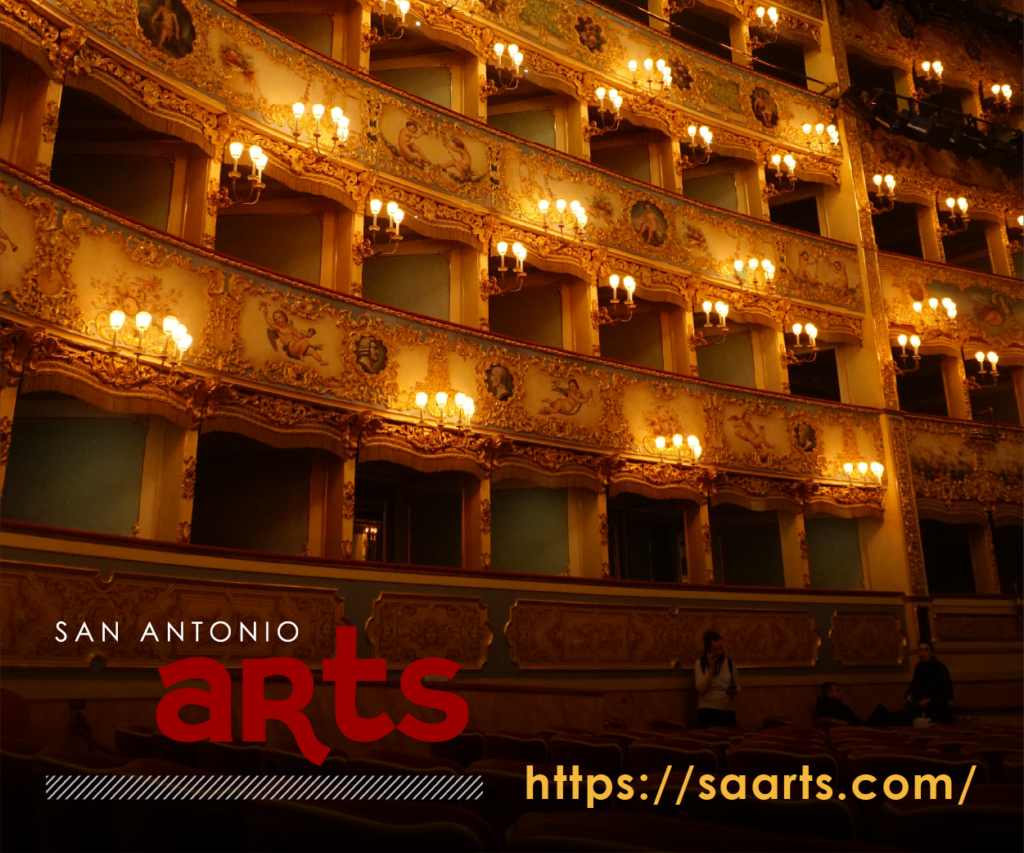
On Dec. 6, 2012, a “topping out ceremony” was held at the construction site of the new Tobin Center for the Performing Arts. A couple of hundred supporters gathered just outside the fenced perimeter of the property to hear civic leaders extol the virtues of the new center and recognize the many community players who helped make this dream a reality. After a few short speeches, a huge crane slowly lifted up a heavy steel beam bearing the U.S. and Texas flags, with a small potted tree between them. As everyone looked skyward, the beam was deposited at the top of what will be the H-E-B Performance Hall, the larger of the two theaters inside the center. Before being hoisted up, it had been signed by just about everyone present. There was a palpable sense of excitement in the crowd.
“One word to describe what’s happening before you is ‘transforming,’” said County Judge Nelson Wolff, summing up everyone’s feelings. The most obvious transformation is, of course, architectural, as the iconic Municipal Auditorium is being turned into a much larger and altogether different edifice. But for San Antonio performing arts organizations and the public at large, the Tobin holds the promise of transforming the entire experience of presenting and appreciating music, opera, dance and theater. When it opens in the fall of 2014, San Antonio will no longer look with envy at Austin’s Long Center or even Houston’s magnificent Wortham Center. We will have our own state-of-the-art performance hall.
It all started in the summer of 2007, when Wolff convened a citizen advisory committee to discuss the need and feasibility for such a facility. “Then in September of 2007, Nelson and I met, and he asked me to form a foundation to take the idea forward,” says J. Bruce Bugg Jr., president and chairman of the Bexar County Performing Arts Center Foundation (BCPACF). Although he’s put endless hours into the project – and his enthusiasm for it is evident – Bugg describes himself as a “loaned executive,” meaning this is a volunteer position for him that takes him away from his primary job as chairman and trustee of the Tobin Endowment. Bugg and Wolff were soon joined by former mayor Phil Hardberger as incorporators of the foundation. District Attorney Susan Reed and former San Antonio Symphony chair Debbie Montford completed the founding board membership. In February of 2008, the city, county and the BCPACF entered into a preliminary agreement regarding an overall financial plan, but nothing could move forward without the voters’ approval of a bond issue that would generate $100 million for the project. Several months later, with that approval in hand, it was clear to the founders that the community as a whole was behind the $203 million undertaking. Today, 91 percent of the needed funds have already been raised, says Bugg, with $108 million from the county, $41 million in land and buildings from the city and the rest raised by the foundation, mostly from major corporate donations. BCPACF must raise another $18 million to complete the construction and secure a $10 million reserve fund.
 “To get to this point, it’s been five years of work, but the results are now becoming visible,” notes Bugg, who donated $15 million from the Tobin Endowment. “The credibility that we now have will help us raise the remaining $18 million. People understand the importance of the center to the community. Among other things, this will be the first acoustically correct building in San Antonio history. It will help us bring the best artists from around the world. It will have a tremendous impact on economic development, and it will have an educational component for our youth. Studies have shown that children who are exposed to the performing arts show higher math and science skills, for instance. All of these things taken together make people recognize that this is an important project in the evolution of culture in San Antonio.” Among the arts organizations scheduled to perform at the Tobin are the San Antonio Symphony, Ballet San Antonio, the Youth Orchestra of San Antonio, the Children’s Choir and the newly formed Opera San Antonio. Others may be added. When completed, the Tobin will be home to a 1,750-seat performance hall and a smaller 250-seat theater for more experimental productions. In addition, there will be a 600-seat outdoor “performance plaza” connecting the center to the riverfront. The most innovative feature is the first-in-the-nation flat-floor mechanism that will make it possible to change the entire floor and seating configuration from a raked theatrical setup to a banquet-style flat surface in 15 minutes. Though it costs an additional $8 million, the mechanized floor makes the big hall more versatile, increasing its revenue potential. A $3 million kitchen will provide catering services.
“To get to this point, it’s been five years of work, but the results are now becoming visible,” notes Bugg, who donated $15 million from the Tobin Endowment. “The credibility that we now have will help us raise the remaining $18 million. People understand the importance of the center to the community. Among other things, this will be the first acoustically correct building in San Antonio history. It will help us bring the best artists from around the world. It will have a tremendous impact on economic development, and it will have an educational component for our youth. Studies have shown that children who are exposed to the performing arts show higher math and science skills, for instance. All of these things taken together make people recognize that this is an important project in the evolution of culture in San Antonio.” Among the arts organizations scheduled to perform at the Tobin are the San Antonio Symphony, Ballet San Antonio, the Youth Orchestra of San Antonio, the Children’s Choir and the newly formed Opera San Antonio. Others may be added. When completed, the Tobin will be home to a 1,750-seat performance hall and a smaller 250-seat theater for more experimental productions. In addition, there will be a 600-seat outdoor “performance plaza” connecting the center to the riverfront. The most innovative feature is the first-in-the-nation flat-floor mechanism that will make it possible to change the entire floor and seating configuration from a raked theatrical setup to a banquet-style flat surface in 15 minutes. Though it costs an additional $8 million, the mechanized floor makes the big hall more versatile, increasing its revenue potential. A $3 million kitchen will provide catering services.
But the feature that attracted the most controversy — and that ultimately changes the appearance of Municipal Auditorium the most – is the enormous 120-foot metal “veil” that will top the renovated structure. Bugg explains that it was necessary to achieve top-notch acoustics. “Municipal Auditorium was originally built on a lead shield underneath, and we were told we couldn’t go below that shield. Since acoustics are driven by volume and size, we had no choice but to go above the existing roofline. Also, because the building will accommodate several entities, the various rooflines needed to be tied together, so the veil was the solution,” he says. The metal “veil” may actually help the building become an attraction in its own right, but how is the Tobin going to help develop bigger audiences for the performing arts beyond the initial excitement of going to a cool new place? Bugg is ready for that question. He has statistics from other cities that decided to build modern performing arts halls. “Revenues and endowments grew exponentially,” says the chairman. In Nashville, for instance, symphony ticket sales went from 1,500,000 to 7, 500,000, a 400-percent jump. Donations soared 147 percent. In Kansas City, the impact was smaller but still substantial: Symphony and ballet ticket sales increased by 67 percent and 85 percent, respectively.
“About 50 percent of San Antonio Symphony’s output sound is lost at the Majestic Theater,” says Bugg. “When Renée Fleming performed last spring, I was sitting in the seventh row, and I couldn’t hear her at times. They had to bring her a mike (normally not needed in opera houses). That will not happen at the Tobin. It’s going to be a difference between night and day. And once people experience symphonic or operatic performance as it should be, the first time they actually hear fully what is being presented on stage, it will be exhilarating. They will want to come back again and again.”






